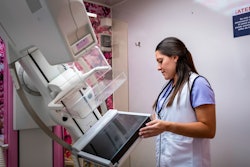Socioeconomic factors arising from social determinants of health can influence adherence to breast cancer screening, researchers have found.
A team led by Lea Sacca, PhD, from Florida Atlantic University in Boca Raton found that insurance status, income, age, and ethnicity are some of the most influential factors in women being able to access breast cancer screening resources. The findings were published February 6 in Frontiers in Public Health, according to a March 4 statement released by the university.
“Efforts to integrate social determinants of health within the different components of intervention planning, implementation, and sustainability are widely gaining recognition, particularly in underserved communities, due to their substantial influence on everyday behaviors,” Sacca and co-authors wrote.
Radiology researchers have explored the impact of health inequities and social determinants of health on adherence and access to breast cancer screening, including attending mammography appointments.
Previous studies have demonstrated how health disparities are tied to delayed mammography screening, leading to higher mortality rates among Hispanic and Black women. Socioeconomic factors that have been linked to screening access include poverty, lack of education, racial discrimination, mortgage discrimination, and lack of support, among others.
Sacca and colleagues performed a review of 72 peer-reviewed observational studies published between 2013 and 2023 to identify the major social determinants of health that act as influential factors to breast cancer screening in U.S. women ages 40 and older.
The researchers focused on the following factors: race and ethnicity, employment, education, food security, insurance status, housing, and access to quality healthcare. Additionally, they reported categories for social detriments of health as defined by Healthy People 2030, an initiative within the U.S. Department of Health and Human Services. The categories include the following: economic stability, education access and quality, healthcare access and quality, neighborhood and built environment, and social and community context.
The studies included in the review showed that the healthcare access and quality category was in the highest number of studies (n = 44, 61%). The study authors highlighted that this demonstrates the category’s significance in relation to mammography access. Analyzing subcategories within healthcare access and quality, the team found that insurance status was the most reported sub-categorical factor with 36 articles.
The team also highlighted the following findings:
- 42 studies (58%) showed statistical significance in the social and community context category, with the highest subcategories being age (63%) and ethnicity (55%) articles designating their significance.
- 28 studies (38%) showed statistical significance under the economic stability category, with income level being the most common subcategorical indicator emphasized in 27% of total studies.
- The neighborhood and built environment category showed statistical significance in 18 (25%) articles, with zip code or geographic location being reported as the strongest sub-categorical indicator in 15 total studies.
- 24 articles showed statistical significance in education access and quality as strong indicators of mammography rate, with the highest level of education completed being the strongest sub-categorical factor in 24 total studies.
The study authors highlighted that their results could inform future evidence-based interventions with the goal of addressing underlying factors contributing to low breast cancer screening rates in the U.S.
The full study can be found here.



















